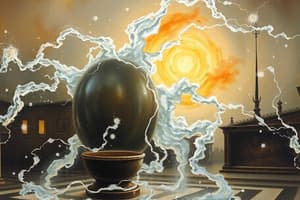Podcast
Questions and Answers
What is the main role of the strong nuclear force?
What is the main role of the strong nuclear force?
- To attract masses towards each other
- To generate electricity
- To hold protons and neutrons together in atomic nuclei (correct)
- To cause radioactive decay
According to Newton's second law of motion, what does F = ma represent?
According to Newton's second law of motion, what does F = ma represent?
- Force equals mass times velocity
- Force equals mass times acceleration (correct)
- Force equals acceleration divided by mass
- Force equals energy times mass
Which law states that energy cannot be created or destroyed?
Which law states that energy cannot be created or destroyed?
- Second Law of Thermodynamics
- First Law of Thermodynamics (correct)
- Third Law of Thermodynamics
- Zeroth Law of Thermodynamics
What type of waves require a medium to travel through?
What type of waves require a medium to travel through?
In Ohm's Law, what does the formula V = IR signify?
In Ohm's Law, what does the formula V = IR signify?
Which of the following forces is responsible for interaction between charged particles?
Which of the following forces is responsible for interaction between charged particles?
What is the main implication of the second law of thermodynamics?
What is the main implication of the second law of thermodynamics?
What does wave-particle duality refer to in quantum mechanics?
What does wave-particle duality refer to in quantum mechanics?
Which of the following is not a basic unit of the SI measurement system?
Which of the following is not a basic unit of the SI measurement system?
What is the characteristic behavior of oscillations?
What is the characteristic behavior of oscillations?
Flashcards are hidden until you start studying
Study Notes
Key Concepts in Physics
Fundamental Forces
- Gravitational Force: Attraction between masses, governed by Newton's Law of Universal Gravitation.
- Electromagnetic Force: Interaction between charged particles; responsible for electricity, magnetism, and light.
- Weak Nuclear Force: Responsible for radioactive decay and nuclear processes.
- Strong Nuclear Force: Holds protons and neutrons together in atomic nuclei.
Classical Mechanics
-
Newton's Laws of Motion:
- An object at rest stays at rest; an object in motion stays in motion unless acted upon by a net force.
- F = ma (Force equals mass times acceleration).
- For every action, there is an equal and opposite reaction.
-
Kinematics: Study of motion without considering its causes.
- Equations of motion for uniformly accelerated motion.
Thermodynamics
-
Laws of Thermodynamics:
- Zeroth Law: If two systems are in thermal equilibrium with a third system, they're in equilibrium with each other.
- First Law: Energy cannot be created or destroyed, only transformed (conservation of energy).
- Second Law: Entropy of an isolated system always increases.
- Third Law: As temperature approaches absolute zero, the entropy of a perfect crystal approaches zero.
-
Heat Transfer: Conduction, convection, and radiation.
Waves and Oscillations
-
Wave Properties:
- Wavelength, frequency, amplitude, speed.
-
Types of Waves:
- Mechanical Waves: Require a medium (e.g., sound waves).
- Electromagnetic Waves: Do not require a medium (e.g., light waves).
-
Oscillations: Back-and-forth motion about an equilibrium position (e.g., pendulums).
Electricity and Magnetism
-
Electric Charge: Fundamental property of matter; positive and negative charges.
-
Ohm's Law: V = IR (Voltage equals current times resistance).
-
Magnetic Fields: Produced by moving electric charges; described by the right-hand rule.
Modern Physics
-
Relativity: Einstein's theories of special and general relativity; effects of speed on time and space.
-
Quantum Mechanics: Behavior of particles at atomic and subatomic levels.
- Wave-particle duality and uncertainty principle.
Units of Measurement
- SI Units: Standardized units for physical quantities.
- Length: meter (m)
- Mass: kilogram (kg)
- Time: second (s)
- Electric current: ampere (A)
- Temperature: kelvin (K)
Key Formulas
- Kinetic Energy: KE = 1/2 mv²
- Potential Energy: PE = mgh
- Momentum: p = mv
- Work: W = Fd (Force times distance)
- Power: P = W/t (Work over time)
Important Concepts
- Conservation Laws: Energy, momentum, and angular momentum are conserved in isolated systems.
- Equilibrium: Static and dynamic equilibrium conditions.
These notes cover fundamental principles and concepts in physics essential for understanding the subject's core ideas.
Fundamental Forces
- Gravitational force is the attraction between masses, described by Newton's Law of Universal Gravitation.
- Electromagnetic force arises from interactions between charged particles, governing electricity, magnetism, and light phenomena.
- Weak nuclear force is responsible for processes like radioactive decay and certain nuclear reactions.
- Strong nuclear force is the binding force that keeps protons and neutrons together within atomic nuclei.
Classical Mechanics
- Newton's First Law states that an object at rest remains at rest, while an object in motion continues moving unless acted upon by a net force.
- Newton's Second Law is expressed as F = ma, illustrating the relationship between force, mass, and acceleration.
- Newton's Third Law posits that for every action, there is an equal and opposite reaction.
- Kinematics focuses on describing motion without analyzing the forces causing it, utilizing equations for uniformly accelerated motion.
Thermodynamics
- The Zeroth Law of Thermodynamics establishes that systems in thermal equilibrium with a third system are in equilibrium with each other.
- The First Law emphasizes the conservation of energy, indicating that energy cannot be created or destroyed, only transformed.
- The Second Law indicates that the entropy of an isolated system tends to increase over time.
- The Third Law states that as temperature approaches absolute zero, the entropy of a perfect crystal approaches zero.
- Heat transfer occurs through conduction, convection, and radiation methods.
Waves and Oscillations
- Wave properties include wavelength, frequency, amplitude, and speed, which define the characteristics of waves.
- Mechanical waves require a medium to travel, such as sound waves in air, while electromagnetic waves (e.g., light waves) do not need a medium.
- Oscillations refer to periodic back-and-forth motions about an equilibrium position, exemplified by pendulums.
Electricity and Magnetism
- Electric charge is a fundamental property of matter characterized as positive or negative.
- Ohm's Law relates voltage, current, and resistance through the equation V = IR, fundamental in electrical circuits.
- Magnetic fields are created by moving electric charges, and their direction can be determined using the right-hand rule.
Modern Physics
- Einstein's theories of relativity explain how speed affects measurements of time and space in special and general relativity.
- Quantum mechanics investigates particle behavior at atomic and subatomic scales, introducing concepts like wave-particle duality and the uncertainty principle.
Units of Measurement
- SI units are standardized units for measuring physical quantities:
- Length is measured in meters (m).
- Mass is expressed in kilograms (kg).
- Time is represented in seconds (s).
- Electric current is measured in amperes (A).
- Temperature is given in kelvins (K).
Key Formulas
- Kinetic Energy is calculated using the formula KE = 1/2 mv², where m is mass and v is velocity.
- Potential Energy is calculated with PE = mgh, where h is height above a reference point.
- Momentum is determined by p = mv, combining mass and velocity.
- Work can be expressed as W = Fd, involving force and distance.
- Power is defined by P = W/t, reflecting the work done over time.
Important Concepts
- Conservation laws state that energy, momentum, and angular momentum remain constant in isolated systems.
- Equilibrium conditions can be classified into static (at rest) and dynamic (in motion) equilibrium scenarios.
Studying That Suits You
Use AI to generate personalized quizzes and flashcards to suit your learning preferences.




